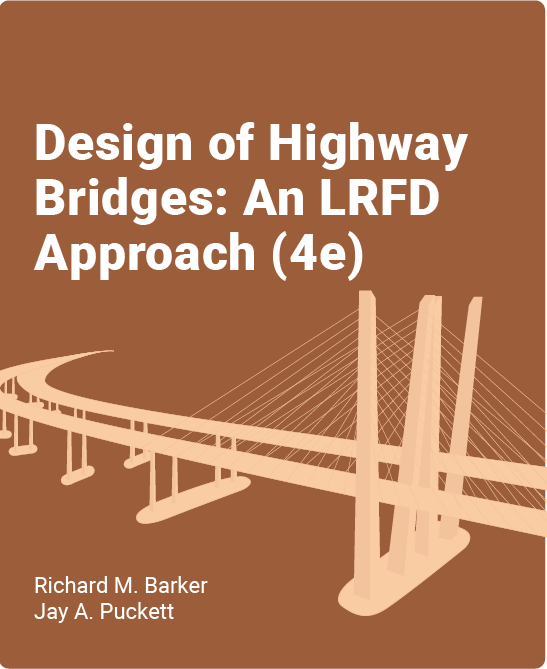Table of Contents
1. Introduction To Bridge Engineering
1.1 A Bridge Is the Key Element in a Transportation System
1.2 Bridge Engineering in the United States
1.2.1 Stone Arch Bridges
1.2.2 Wooden Bridges
1.2.3 Metal Truss Bridges
1.2.4 Suspension Bridges
1.2.5 Metal Arch Bridges
1.2.6 Reinforced Concrete Bridges
1.2.7 Girder Bridges
1.2.8 Closing Remarks
1.3 Bridge Engineer—Planner, Architect, Designer, Constructor, and Facility Manager
References
Problems
2. Specifications and Bridge Failures
2.1 Bridge Specifications
2.2 Implication of Bridge Failures on Practice
2.2.1 Silver Bridge, Point Pleasant, West Virginia, December 15, 1967
2.2.2 I-5 and I-210 Interchange, San Fernando, California, February 9, 1971
2.2.3 Sunshine Skyway, Tampa Bay, Florida, May 9, 1980
2.2.4 Mianus River Bridge, Greenwich, Connecticut, June 28, 1983
2.2.5 Schoharie Creek Bridge, Amsterdam, New York, April 5, 1987
2.2.6 Cypress Viaduct, Loma Prieta Earthquake, October 17, 1989
2.2.7 I-35W Bridge, Minneapolis, Minnesota, August 1, 2007
2.2.8 Failures during Construction
2.2.9 Failures Continue and Current Data
2.2.10 Evolving Bridge Engineering Practice
References
Problems
3.Bridge Aesthetics
3.1 Introduction
3.2 Nature of the Structural Design Process
3.2.1 Description and Justification
3.2.2 Public and Personal Knowledge
3.2.3 Regulation
3.2.4 Design Process
3.3 Aesthetics in Bridge Design
3.3.1 Definition of Aesthetics
3.3.2 Qualities of Aesthetic Design
3.3.3 Practical Guidelines for Medium- and Short-Span Bridges
3.3.4 Computer Modeling
3.3.5 Web References
3.3.6 Closing Remarks on Aesthetics
References
Problems
4. Bridge Types and Selection
4.1 Main Structure below the Deck Line
4.2 Main Structure above the Deck Line
4.3 Main Structure Coincides with the Deck Line
4.4 Closing Remarks on Bridge Types
4.5 Selection of Bridge Type
4.5.1 Factors To Be Considered
4.5.2 Bridge Types Used for Different Span Lengths
4.5.3 Closing Remarks
References
Problems
5. Design Limit States
5.1 Introduction
5.2 Development of Design Procedures
5.2.1 Allowable Stress Design
5.2.2 Variability of Loads
5.2.3 Shortcomings of Allowable Stress Design
5.2.4 Load and Resistance Factor Design
5.3 Design Limit States
5.3.1 General
5.3.2 Service Limit State
5.3.3 Fatigue and Fracture Limit State
5.3.4 Strength Limit State
5.3.5 Extreme Event Limit State
5.3.6 Construction Limit States
5.4 Closing Remarks
References
Problems
6.Principles of Probabilistic Design
6.1 Introduction
6.1.1 Frequency Distribution and Mean Value
6.1.2 Standard Deviation
6.1.3 Probability Density Functions
6.1.4 Bias Factor
6.1.5 Coefficient of Variation
6.1.6 Probability of Failure
6.1.7 Safety Index 𝛽
6.2 Calibration of LRFD Code
6.2.1 Overview of the Calibration Process
6.2.2 Calibration Using Reliability Theory
6.2.3 Calibration of Fitting with ASD
6.3 Closing Remarks
References
Problems
7. Geometric Design Considerations
7.1 Introduction to Geometric Roadway Considerations
7.2 Roadway Widths
7.3 Vertical Clearances
7.4 Interchanges
References
Problem
8. Loads
8.1 Introduction
8.2 Gravity Loads
8.2.1 Permanent Loads
8.2.2 Transient Loads
8.3 Lateral Loads
8.3.1 Fluid Forces
8.3.2 Seismic Loads
8.3.3 Ice Forces
8.4 Forces Due to Deformations
8.4.1 Temperature
8.4.2 Creep and Shrinkage
8.4.3 Settlement
8.5 Collision Loads
8.5.1 Vessel Collision
8.5.2 Rail Collision
8.5.3 Vehicle Collision
8.6 Blast Loading
8.7 Summary
References
Problems
9. Influence Functions and Girder-Line Analysis
9.1 Introduction
9.2 Definition
9.3 Statically Determinate Beams
9.3.1 Concentrated Loads
9.3.2 Uniform Loads
9.4 Muller–Breslau Principle
9.4.1 Betti’s Theorem
9.4.2 Theory of Muller–Breslau Principle
9.4.3 Qualitative Influence Functions
9.5 Statically Indeterminate Beams
9.5.1 Integration of Influence Functions
9.5.2 Relationship between Influence Functions
9.5.3 Muller–Breslau Principle for End Moments
9.5.4 Automation by Matrix Structural Analysis
9.6 Normalized Influence Functions
9.7 AASHTO Vehicle Loads
9.8 Influence Surfaces
9.9 Summary
References
Problems
10. System Analysis—Introduction
10.1 Introduction
10.2 Safety of Methods
10.2.1 Equilibrium for Safe Design
10.2.2 Stress Reversal and Residual Stress
10.2.3 Repetitive Overloads
10.2.4 Fatigue and Serviceability
10.3 Summary
References
Problem
11. System Analysis—Gravity Loads
11.1 Slab Girder Bridges
11.2 Slab Bridges
11.3 Slabs in Slab Girder Bridges
11.4 Box Girder Bridges
11.5 Closing Remarks
References
Problems
12. System Analysis—Lateral, Temperature, Shrinkage, and Prestress Loads
12.1 Lateral Load Analysis
12.1.1 Wind Loads
12.1.2 Seismic Load Analysis
12.2 Temperature, Shrinkage, and Prestress
12.2.1 General
12.2.2 Prestressing
12.2.3 Temperature Effects
12.2.4 Shrinkage and Creep
12.3 Closing Remarks
References
Part III Concrete Bridges
13. Reinforced Concrete Material Response and Properties
13.1 Introduction
13.2 Reinforced and Prestressed Concrete Material Response
13.3 Constituents of Fresh Concrete
13.4 Properties of Hardened Concrete
13.4.1 Short-Term Properties of Concrete
13.4.2 Long-Term Properties of Concrete
13.5 Properties of Steel Reinforcement
13.5.1 Nonprestressed Steel Reinforcement
13.5.2 Prestressing Steel
References
Problems
14. Behavior of Reinforced Concrete Members
14.1 Limit States
14.1.1 Service Limit State
14.1.2 Fatigue Limit State
14.1.3 Strength Limit State
14.1.4 Extreme Event Limit State
14.2 Flexural Strength of Reinforced Concrete Members
14.2.1 Depth to Neutral Axis for Beams with Bonded Tendons
14.2.2 Depth to Neutral Axis for Beams with Unbonded Tendons
14.2.3 Nominal Flexural Strength
14.2.4 Ductility, Maximum Tensile Reinforcement, and Resistance Factor Adjustment
14.2.5 Minimum Tensile Reinforcement
14.2.6 Loss of Prestress
14.3 Shear Strength of Reinforced Concrete Members
14.3.1 Variable-Angle Truss Model
14.3.2 Modified Compression Field Theory
14.3.3 Shear Design Using Modified Compression Field Theory
14.4 Closing Remarks
References
Problems
15. Concrete Barrier Strength and Deck Design
15.1 Concrete Barrier Strength
15.1.1 Strength of Uniform Thickness Barrier Wall
15.1.2 Strength of Variable Thickness Barrier Wall
15.1.3 Crash Testing of Barriers
15.2 Concrete Deck Design
References
Problems
16. Concrete Design Examples
16.1 Solid Slab Bridge Design
16.2 T-Beam Bridge Design
16.3 Prestressed Girder Bridge
References
17. Steel Bridges
17.1 Introduction
17.2 Material Properties
17.2.1 Steelmaking Process: Traditional
17.2.2 Steelmaking Process: Mini Mills
17.2.3 Steelmaking Process: Environmental Considerations
17.2.4 Production of Finished Products
17.2.5 Residual Stresses
17.2.6 Heat Treatments
17.2.7 Classification of Structural Steels
17.2.8 Effects of Repeated Stress (Fatigue)
17.2.9 Brittle Fracture Considerations
17.3 Summary
References
Problem
18. Limit States and General Requirements
18.1 Limit States
18.1.1 Service Limit State
18.1.2 Fatigue and Fracture Limit State
18.1.3 Strength Limit States
18.1.4 Extreme Event Limit State
18.2 General Design Requirements
18.2.1 Effective Length of Span
18.2.2 Dead-Load Camber
18.2.3 Minimum Thickness of Steel
18.2.4 Diaphragms and Cross Frames
18.2.5 Lateral Bracing
References
Problems
19. Steel Component Resistance
19.1 Tensile Members
19.1.1 Types of Connections
19.1.2 Tensile Resistance—Specifications
19.1.3 Strength of Connections for Tension Members
19.2 Compression Members
19.2.1 Column Stability—Behavior
19.2.2 Inelastic Buckling—Behavior
19.2.3 Compressive Resistance—Specifications
19.2.4 Connections for Compression Members
19.3 I-Sections in Flexure
19.3.1 General
19.3.2 Yield Moment and Plastic Moment
19.3.3 Stability Related to Flexural Resistance
19.3.4 Limit States
19.3.5 Summary of I-Sections in Flexure
19.3.6 Closing Remarks on I-Sections in Flexure
19.4 Shear Resistance of I-Sections
19.4.1 Beam Action Shear Resistance
19.4.2 Tension Field Action Shear Resistance
19.4.3 Combined Shear Resistance
19.4.4 Shear Resistance of Unstiffened Webs
19.5 Shear Connectors
19.5.1 Fatigue Limit State for Stud Connectors
19.5.2 Strength Limit State for Stud Connectors
19.6 Stiffeners
19.6.1 Transverse Intermediate Stiffeners
19.6.2 Bearing Stiffeners
References
Problems
20. Steel Design Examples
20.1 Noncomposite Rolled Steel Beam Bridge
20.2 Composite Rolled Steel Beam Bridge
20.3 Multiple-Span Composite Steel Plate Girder Beam Bridge
20.3.1 Problem Statement Example
References
Appendix A Influence Functions For Deck Analysis
Appendix B Transverse Deck Moments Per AASHTO Appendix A4
Appendix C Metal Reinforcement Information
Appendix D Refined Estimate of Time-Dependent Losses
References
Appendix E NCHRP 12-33 Project Team
Task Groups
Appendix F Live-Load Distribution—Rigid Method
Index
zyText are leading print textbooks available in full on the zyBooks platform. Each zyText has been adapted to include learning questions and answer-specific feedback allowing for a quick and easy transition to an engaging digital experience for instructors and students.
What You’ll Find in this zyText
- Incorporates the complete text
- Over 150 learning questions with answer-specific feedback
- Customization tools letting you add, remove or reorder chapters and sections
- Options to align the book directly to your syllabus – including videos, images, text
- Analytics that help you measure student engagement
- Ability to hold students accountable for reading before class
- A competitive low price point
- Students can keep a PDF version of key chapters at no additional cost
A comprehensive introduction to the latest construction methods and materials in bridge design, revised to reflect the eighth edition of the AASHTO LRFD specifications and including:
- Accelerated Bridge Construction (ABC)
- Ultra-high performance concrete (UHPC)
- Practical 3D Rigorous Analysis
- Dozens of end-of-chapter worked problems and design examples based on the latest AASHTO LRFD Specifications
From gaining base knowledge of the AASHTO LRFD specifications to detailed guidance on highway bridge design, Design of Highway Bridges is the one-stop reference for civil engineering students and a key study resource for those seeking engineering licensure through the Principles and Practice of Engineering (PE) exam.
Authors
Richard M. Barker
Jay A. Puckett

